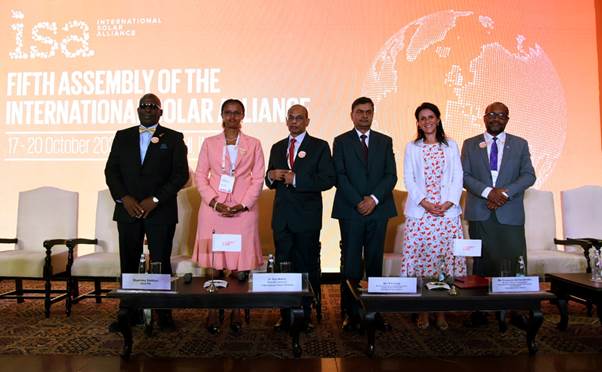Description

Copyright infringement not intended
Context: The Fifth Assembly of the International Solar Alliance was inaugurated by Shri Raj Kumar Singh, Minister of Power and New & Renewable Energy, India in his capacity as the President, International Solar Alliance. Ministers from 20 countries and delegates from across 110 Member and Signatory countries and 18 prospective countries joined the inaugural ceremony of the 5th ISA Assembly.
Details:
More on the news:
- To bolster investments in solar power projects, the International Solar Alliance (ISA), in its General Assembly meeting, approved the ‘Solar Facility’, a payment guarantee mechanism expected to stimulate investments into solar projects through two financial components — a Solar Payment Guarantee Fund and Solar Insurance Fund.
- The thrust of the facility is to attract private capital to flow into “underserved markets” in Africa.
- The ISA would aim to crowdsource investments from various donors across the globe and proposed projects in Africa would be able to purchase payment guarantees or partial insurance premium from these funds, said a statement from the ISA.
- With the Solar Facility, ISA is looking to support projects by reducing lenders’ apprehensions and enabling finance to flow for projects that otherwise may not have received funding
- ISA’s mission is to unlock US $1 trillion (₹80 lakh crore) of investments in solar power by 2030 while reducing cost of the technology and its financing.
About:
- The Assembly is the apex decision-making body of ISA, in which each Member Country is represented.
- This body makes decisions concerning the implementation of the ISA’s Framework Agreement and coordinated actions to be taken to achieve its objective.
- The Assembly meets annually at the ministerial level at the ISA’s seat.
- It assesses the aggregate effect of the programmes and other activities in terms of deployment of solar energy, performance, reliability, cost, and scale of finance.
- The Fifth Assembly of the ISA will deliberate on the key initiatives of ISA on three critical issues energy access, energy security, and energy transition.
About International Solar Alliance:
- The International Solar Alliance (ISA) is an alliance of 121 countries initiated by India, most of them being sunshine countries, which lie either completely or partly between the Tropic of Cancer and the Tropic of Capricorn.
- The primary objective of the alliance is to work for efficient exploitation of solar energy to reduce dependence on fossil fuels.
- The alliance is also called International Agency for Solar Policy and Application (IASPA).
- This initiative was first proposed by Indian Prime Minister Narendra Modi.
- The alliance is a treaty-based inter-governmental organization. Countries that do not fall within the Tropics can join the alliance and enjoy all benefits as other members, with the exception of voting rights. After the United Nations, it is the largest grouping of states world-wide.
- The Headquarters is in India with its Interim Secretariat being set up in Gurugram.
- The International Solar Alliance is an international organisation with 110 Member and Signatory countries.
- It works with governments to improve energy access and security worldwide and promote solar power as a sustainable way to transition to a carbon-neutral future
- It promotes the use of solar energy in the Agriculture, Health, Transport and Power Generation sectors.
- ISA member countries are driving change by enacting policies and regulations, sharing best practices, agreeing on common standards, and mobilising investments.
- Through this work, ISA has identified and designed and tested new business models for solar projects; supported governments to make their energy legislation and policies solar-friendly through Ease of Doing Solar analytics and advisory; pooled demand for solar technology from different countries; and drove down costs; improved access to finance by reducing the risks and making the sector more attractive to private investment; increased access to solar training, data and insights for solar engineers and energy policymakers.
- With the signing and ratification of the ISA Framework Agreement by 15 countries on 6 December 2017, ISA became the first international intergovernmental organisation to be headquartered in India.
- ISA is partnering with multilateral development banks (MDBs), development financial institutions (DFIs), private and public sector organisations, civil society, and other international institutions to deploy cost-effective and transformational solutions through solar energy, especially in the least Developed Countries (LDCs) and the Small Island Developing States (SIDS).
- The United Nations General Assembly (UNGA) has granted Observer Status to the International Solar Alliance (ISA).

Vision:
Let us together make the sun brighter.
Mission:
Every home, no matter how far away, will have a light at home.
What are the Important projects of the ISA?
- One Sun One World One Grid (OSOWOG): The OSOWOG focuses on a framework for facilitating global cooperation, building a global ecosystem of interconnected renewable energy resources (mainly solar energy) that can be seamlessly shared.
- ISA Solar Technology and Application Resource Centre (ISTAR C): To build a network of technical training, entrepreneurship, and research and innovation centres in order to exchange best practices and promote knowledge dissemination and capacity-building.
- Indian Technical and Economic Cooperation (ITEC) Scheme: The Government of India has been supporting the ISA by providing training to master trainers in the field of solar energy through the Indian Technical and Economic Cooperation (ITEC) Scheme.
What are the Important Solar Energy Initiatives of India?
- National Solar Mission
- INDC’s target
- Solar Park Scheme
- Canal bank & Canal top Scheme
- Bundling Scheme
- Grid Connected Solar Rooftop Scheme
https://www.pib.gov.in/PressReleasePage.aspx?PRID=1868849











